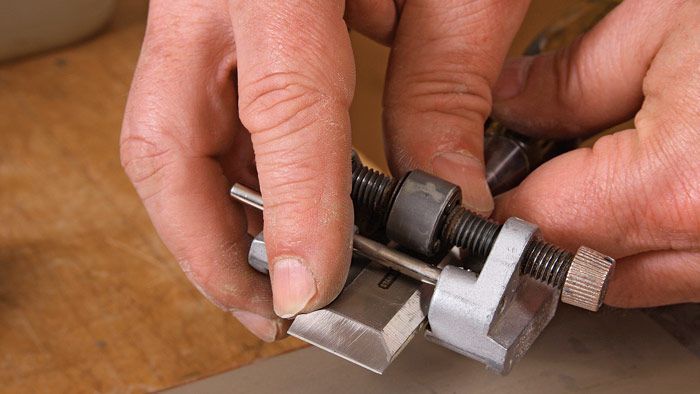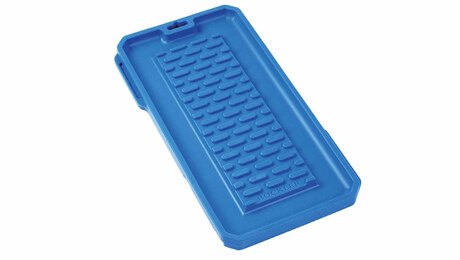Q&A: Why do I still have tiny scratches on my blade?
Mike Pekovich and Tom McKenna offer tips for getting a perfect mirror polish on your blades
Question from Josh: I see pictures posted online where people have gotten a completely mirror polished edge on a chisel or plane iron. I’m using a Norton 1000 grit water stone, followed by a King 3000, followed by a Norton 8000 stone, but I can’t seem to get that mirror polish. I still end up with some scratches, no matter how long I work with the 8000 stone, even when honing a new blade. I know Mike recommends 1000/4000/8000, but Lie Nielsen skips the intermediate grit, so I don’t think the 3000 stone is my problem. I’ve thought about trying to get a finer stone than the 8000 I have, but I don’t want a $100 experiment.

Mike Pekovich: I would say, first of all, the vast majority of the time, if I got a powerful magnifying glass and looked at my blades after honing them really well, they’re still going to have some fine scratches here and there. But if you have a mirror polish overall and deep scratches, it means that there are some heavier scratches that happen somewhere that the eight thousand grit stone is just not capable of getting rid of, and going to an even finer grit stone isn’t going to help you out. I also think the idea that you don’t need another intermediate grit is probably true. On the other hand, since you’ve got a Norton 1000 and a King 3000, you could have a problem because the grits of water stones (especially Norton and King) are measured in different ways. In fact, I think that a King 3000 is actually a really fine stone. So part of the problem could be that you’re mixing and matching.
Another thing is that if you’re using a honing guide, you could inadvertently be bringing some of the coarser grit from the 1000 or the 3000 stone to the 8000 stone on the wheel of the guide. Or, if there’s any water still hanging onto the blade as you move from stone to stone, that water can contain the swarf or the grit from the coarser stone, too. That’s why it’s important to spray off your blade and honing guide between stones and then wipe them off really well.
I can think of a technique that may help you out, too. Get a fresh grind on your blades and then throw them in a honing guide at a slightly finer angle so that you’re only removing a really thin line of steel along the cutting edge as you’re sharpening. That way you’re removing a lot less steel and you can work all the way through each stone much faster and give yourself a better chance of working each scratch pattern out fully. Then do a really good job of spraying off and wiping down the blade and the wheel as you go, and I think you’ll have much better results.

Tom McKenna: I had a similar problem a long time ago and Mike asked me, “Are you pressing too hard?” It turned out I was really monkeying down on my blades instead of letting the stone and the honing guide do their work. By pressing too hard, I was scratching the blade pretty deeply and since I stopped doing that I’m getting a much better final polish. I’m also using all the same brand stones and wiping them off between grits as Mike suggested.
Mike: I also find that if you start with a diamond plate and then move up to water stones, the diamond plates can create a deep scratch pattern that water stones have a hard time reconciling. That’s because the grit on a diamond plate is basically attached to the surface of the plate, instead of being embedded in it, so even if the grit is fairly fine, it’s sticking up quite high. That’s why I don’t recommend starting on a diamond plate.
Ben Strano: In my experience, there’s a break-in period with Diamond stones where–
Mike: They’re really fast at first!

Ben: Yeah and it takes longer to get rid of the scratches. I have similar scratches in some of my chisels that are from the break-in period from my course diamond plate. But the scratches don’t really matter… because the chisels work.
Tom: I agree. I was just going to say, if your blade is cutting well then don’t worry about the scratches.
This conversation was excerpted from Shop Talk Live episode 182.
Fine Woodworking Recommended Products

Honing Compound

Rockler Silicone Sharpening Stone Tray






















Comments
As a professional straight razor restorer and honer, I have some experience honing with natural and synthetic stones.
Deep scratches, (stria) usually are from the grinding, bevel setting stone, usually 1,000 grit or from damage prior to honing that was not removed by the bevel setting stone. You only see the deep stria at the finish stone because all the other stria has been polished off.
For sharpening tools, you can use a progression of grits but because the contact area is so small you can make large grit jumps successfully. 8k grit should be the minimum for a finished edge. Steel does not get straight until 8k, with Straight Razors we routinely go to much higher grits for keenness and comfort, up to 160,000 grit, but usually .50 um 20-30,00- grit equivalent. I use a 60-100X handheld scope when honing.
Yes, some Waterstone manufacturers do use different grit rating systems, but it is never enough to worry about in a progression. I have stones from most of the manufactures and mix them all the time without issue.
Make sure your stone is lapped and clean first and take your honing to at least, 8k and finish by stropping on Chromium Oxide rated at .50um – 30,000 grit, pasted on a piece of cardboard from the inside of a cereal box,(you don’t need a lot) any good metal polish works well also and will get you to a mirror finish easily. The grit rating of metal polish is unknown as their blends are proprietary.
Do not use excessive pressure or you can microscopically roll the edge. But if you do, a few laps on the 8k or your finish stone, will bring it back easily.
I know it's a personal thing, but it confounds me that Mike still recommends sharpening using a honing jig. Freehand sharpening of chisels and plane irons, particularly on a hollow grind, is as fundamental a woodworking skill as sawing straight. It's so basic that it's literally the first thing one learns at a fundamentals course. Why recommend a crutch that impedes a truly fundamental skill?
I'd phrase it a little differently: Sharpening is a fundamental skill, but freehand honing is only one path to get you there. I honed exclusively by hand for a long time, but a honing guide is simple and fast and it gets me just as sharp. More important, it makes it easy for newer woodworkers to get sharp as well. And until you're sharp, your tools aren't going to be able to do what you need them to. I don't place a honing guide in the same category as a sawing guide, which I do try and discourage students from using. In the classes I teach, my emphasis is on building hand skills which are the foundation of doing good work, and sharp tools are just the start. In working with a lot of students, I've found that sharpening is the biggest stumbling block when trying to introduce hand tools into their work, so if there's a way to make that easier, I'm all for it.
Spend more time on the intermediate (3000) stone to remove the previous marks to create a semi-polished surface and the 8000 stone will give you better results. As mentioned before avoid cross contamination as much as possible. A soft touch works better also to prevent creating deep grooves in the first place.
Log in or create an account to post a comment.
Sign up Log in